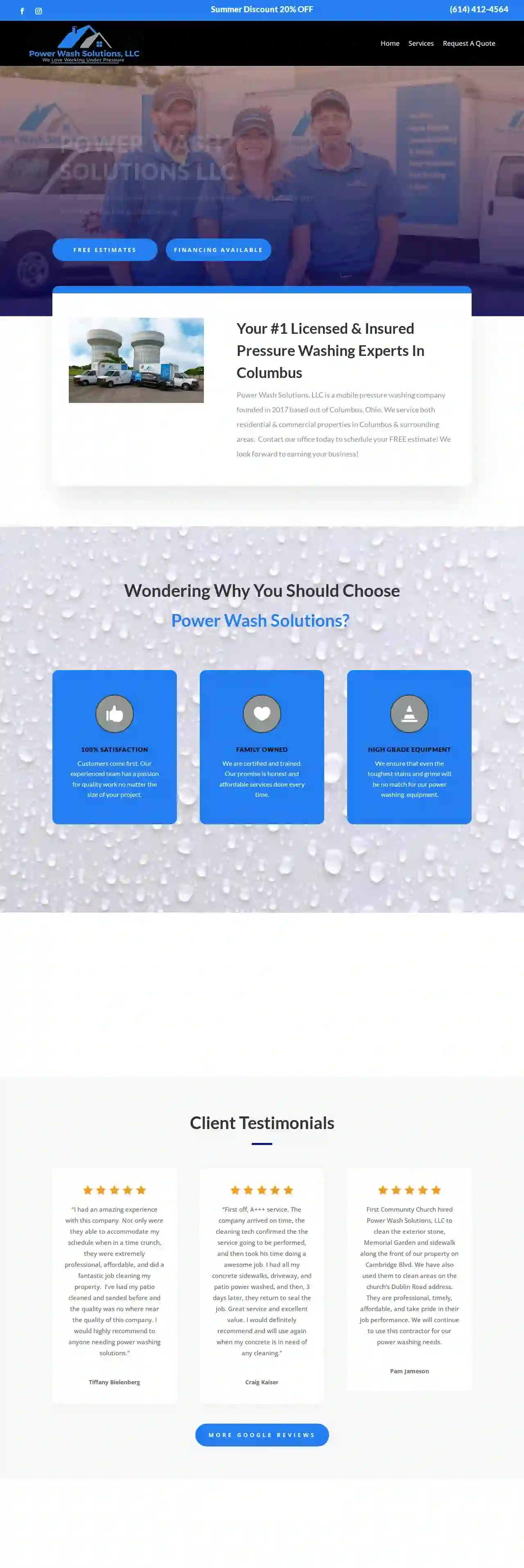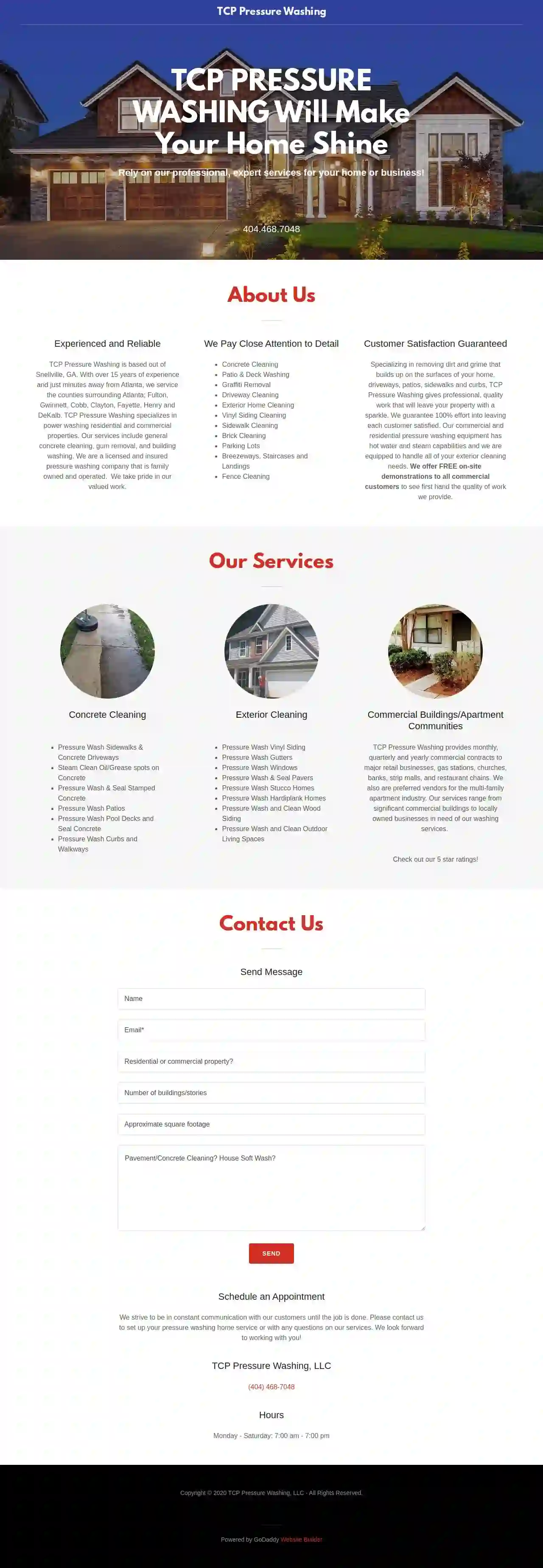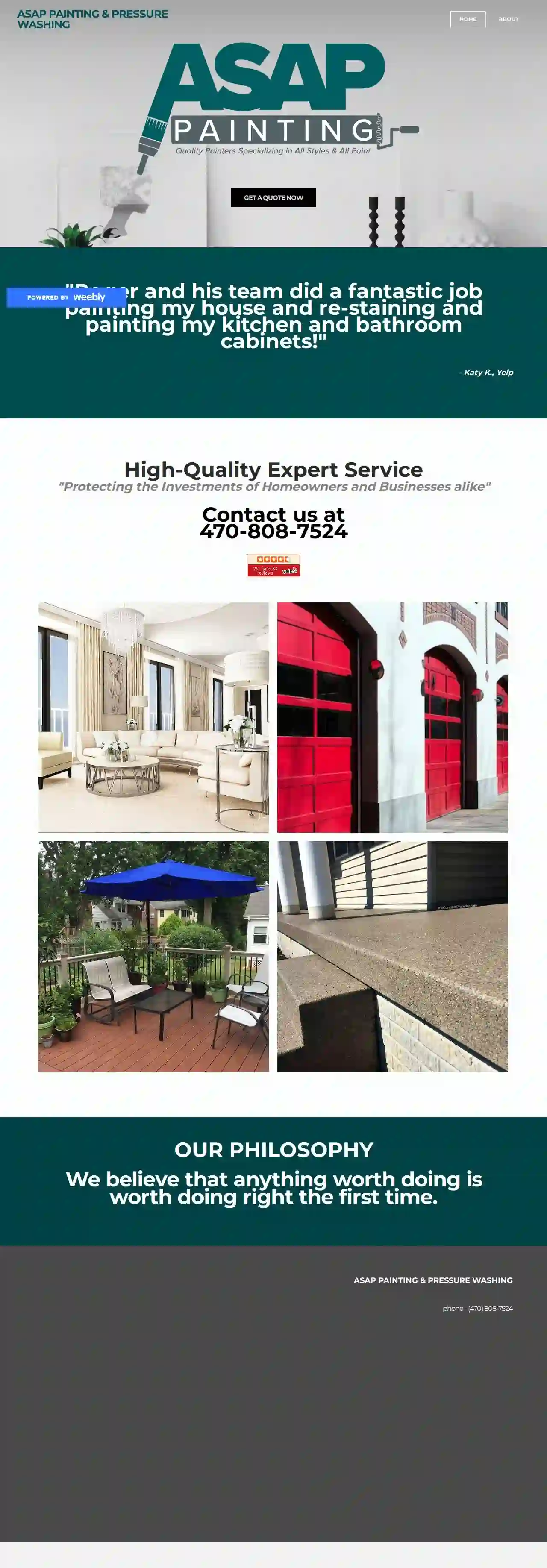Pressure Washing Forest Park
Find Power Washing in Forest Park
Get multiple Driveway Cleaning quotes for your project today! Compare profiles, reviews, accreditations, portfolio, etc... and choose the best service.

Nick's Cleaning Service
519 reviewsAtlanta, 30316, USContact Nick’s Cleaning Service for the best residential & commerical cleaning in atlanta & surrounding county’s! Our services include carpet cleaning, tile and grout cleaning, stain removal, pet odor control, upholstery cleaning, hardwood floor services, area rugs, pressure washing, mobile auto detailing cleaning, and commercial janitorial services.Results guaranteed!
- Services
- Why Us?
- Our Team
- Testimonials
- Gallery
Get Quote
Power Wash Solutions, LLC
586 reviewsColumbus, USPower Wash Solutions, LLC is a mobile pressure washing company founded in 2017 based out of Columbus, Ohio. We service both residential & commercial properties in Columbus & surrounding areas. Our experienced team has a passion for quality work no matter the size of your project. We are certified and trained. Our promise is honest and affordable services done every time. We ensure that even the toughest stains and grime will be no match for our power washing equipment. Contact our office today to schedule your FREE estimate! We look forward to earning your business!
- Services
- Why Us?
- Testimonials
- Gallery
Get Quote
Cleantech
4.717 reviewsColumbus, OH, 9118 Antares Ave, 43240, USAt Cleantech Power Washing, we specialize in bringing the brightest and cleanest surfaces to life, combining modern, effective techniques with a commitment to customer satisfaction. With over two decades in the power washing industry, we’re experienced and dedicated to delivering top-notch residential and commercial cleaning at highly competitive rates. Whether it’s a house facade, the exterior of a commercial property, or a parking lot, our team is here to improve the exterior of your property and enhance its curb appeal.
- Services
- Why Us?
- Accreditations
- Our Team
- Testimonials
- Gallery
Get Quote
So Fresh Pressure Washing LLC
516 reviews618 Hastings Way, Jonesboro, 30238, USGive Your Property a Fresh Look Give Us a Call Today 470-917-3041 Get a Free Quote So Fresh Pressure Washing LLC is a reliable and knowledgeable business for professional pressure washing in the Stockbridge area. We offer residential and commercial pressure washing services in ten cities and surrounding areas to serve you. Our service professionals are all licensed and insured. They have had the best training and know which methods and cleaning solutions will provide the best results for your property. Our goal is to make our customers happy, provide them with the best possible service, and make their lives easier by doing all the dirty work for them! So Fresh Pressure Washing LLC was founded in 2020 by its owner, Jay. With over five years of experience, Jay and his employees strive to make every interaction with a customer a memorable one. They provide a wide variety of pressure washer services in Stockbridge and surrounding areas. Not only do they provide general pressure washing services, but some original services offered by the business are graffiti removal, parking lot washing, commercial pressure washing, and various residential pressure washer services, including roof cleaning, driveway washing, gutter cleaning, and house washing. "So Fresh Pressure Washing LLC is a business built on quality and integrity. We have a diverse range of pressure washer services in Stockbridge and surrounding areas, from commercial cleaning to residential and fleet services. We are licensed and insured and can guarantee satisfaction." - Jay, owner of So Fresh Pressure Washing LLC If you're in the market for pressure washing in Stockbridge, give Jay and his team a call! Jay and his staff of trained and professional pressure washers provide friendly, prompt service to all their customers.
- Services
- Why Us?
- Accreditations
- Our Team
- Gallery
Get Quote
Blue Monkey Pressure Washing & Wood Care
4.991 reviewsMarietta, 48610, USBlue Monkey Pressure Washing and Wood Care is a family-owned and operated professional exterior cleaning company based in Cobb County, GA. We pride ourselves on offering safe and effective residential and commercial pressure washing and wood care services including wood staining and small repairs. Don’t let an inexperienced weekend warrior, with the promise of a cheap house wash, drench your home with bleach, kill your plants, or use damaging high pressure on your largest investment. The Blue Monkey Pressure Washing and Wood Care cleaning process is both safe and effective allowing us to achieve superior results without the threat of any damage. Our washing products are effective at removing mold, mildew, dirt, and grime while being biodegradable and safe for people, plants, and animals. Our goal is to clean your house using as little pressure as possible, virtually eliminating concerns of water being forced behind siding, paint being blown off or water being pushed in around windows and doors. We use non-aggressive biodegradable-based cleaners & prep your home before we wash to assure no harm is done to your electrical outlets, keypads, doorbells, flowers, plants, furniture, or any other delicate items. Blue Monkey does not use damaging high-pressure or overly high concentrations of bleach. We use our very own special blend of eco-friendly soaps & surfactants and offer citrus detergents for those who are sensitive to salt-based soaps. We offer the top-rated pressure washing service as well as gutter cleaning, house washing, and much more! Call today for a fast and free quote.
- Services
- Why Us?
- Our Team
- Testimonials
- Gallery
Get Quote
TCP Pressure Washing
5355 reviewsSnellville, GA, 30078, USTCP Pressure Washing is a professional, expert pressure washing company based out of Snellville, GA, with over 15 years of experience. We specialize in power washing residential and commercial properties, including general concrete cleaning, gum removal, and building washing. We are a licensed and insured pressure washing company that is family owned and operated. We take pride in our valued work and guarantee 100% customer satisfaction. Our services include concrete cleaning, patio and deck washing, graffiti removal, driveway cleaning, exterior home cleaning, vinyl siding cleaning, sidewalk cleaning, brick cleaning, parking lots, breezeways, staircases, and landings, and fence cleaning. We also offer free on-site demonstrations to commercial customers and provide monthly, quarterly, and yearly commercial contracts to major retail businesses, gas stations, churches, banks, strip malls, and restaurant chains.
- Services
- Why Us?
- Gallery
Get Quote
Scrubbing Sam's Cleaning & Power Wash
553 reviews25132 SW 1st Ave, Newberry, 32669, USWelcome to Scrubbing Sam’s Cleaning and Power Wash, your top professionals in the pressure washing industry! Tired of a dirty exterior? We understand the frustration. At Scrubbing Sam’s, our extensive knowledge and customer service will make your property shine bright in the neighborhood! We take pride in our attention to detail, using advanced techniques to revitalize your space. Say goodbye to mold, dirt, algae and hello to pristine perfection. Let us be the peace of mind you deserve, delivering unmatched quality that stands head and shoulders above the rest.Elevate your property with Scrubbing Sam’s – where cleanliness is an art, and excellence is our promise.
- Services
- Why Us?
- Gallery
Get Quote
ASAP Painting & Pressure Washing
4.946 reviews123 Main St, Suite 100, Atlanta, 30301, USASAP PAINTING & PRESSURE WASHING is a high-quality expert service dedicated to protecting the investments of homeowners and businesses alike. Our philosophy is to ensure that anything worth doing is worth doing right the first time. We offer a range of services including painting and re-staining, and our team is committed to providing excellent customer service.
- Services
- Why Us?
- Accreditations
- Our Team
- Testimonials
- Gallery
Get Quote
Savannah River Pressure Washing
5169 reviewsEvans, GA, 2012 Highgrass Ct, 30809, USSavannah River Pressure Washing is the premier name in top-notch pressure washing services for home and business properties alike. We're a company that delivers quality results each and every time. Our team of skilled pros offers a wide range of high-quality exterior cleaning services to fit just about any need you might have. Whether you're looking for soft washing, house washing, commercial exterior cleaning, or even gutter cleaning, we can get the job done. We're licensed, insured, experienced, and OSHA Industrial Safety Certified. We offer appreciation discounts for active-duty military, veterans, first responders, educators, and health care workers. We're a company that values honesty, reliability, and communication with knowledgeable employees. We provide timely estimates with digital quotes for services requested and responsible, ethical employees who care for your property and belongings. We accept cash, check, Venmo, and Zelle payment options. Learn more about us and our services.
- Services
- Why Us?
- Testimonials
- Gallery
Get Quote
Original Pro-Wash
51 reviewsAtlanta, USOriginal Pro-Wash has been providing the best services to Metro Atlanta and surrounding areas. Superior quality and exceptional customer service are guaranteed when you work with us.
- Services
- Why Us?
- Gallery
Get Quote
Over 60,241+ Cleaning Businesses registered
Our cleaning service providers operate in Forest Park and beyond!
CleaningMatch has curated and vetted the Best Cleaning Contractors in Forest Park. Find the most reliable contractor today.
Frequently Asked Questions About Pressure Washing
- Pressure Washing: If your siding is in good condition but dirty or stained, pressure washing can effectively restore its appearance without the need for painting.
- Painting: If your siding is faded, chipped, peeling, or damaged, pressure washing alone may not be sufficient. Painting provides a fresh coat of protection and a new look.
- Pressure Washing Before Painting: Pressure washing is an essential step before painting, as it removes dirt, grime, and loose paint, creating a clean surface for the new paint to adhere to.
- Pressure Washing: For hard surfaces like concrete, brick, or decks, pressure washing can effectively remove mold and mildew. Use a cleaning solution containing bleach or mildewcide for optimal results.
- Soft Washing: For delicate surfaces like roofs or siding, soft washing is the preferred method for mold and mildew removal. Soft washing uses low-pressure water and specialized cleaning solutions to gently remove mold and mildew without damaging the surface.
- Prevention: After cleaning, take steps to prevent future mold and mildew growth by addressing moisture issues, such as fixing leaks, improving ventilation, and trimming vegetation that creates shade and traps moisture.
- Wear Protective Gear: Wear safety glasses, closed-toe shoes, and long pants to protect yourself from flying debris and water spray.
- Never Point the Nozzle at Yourself or Others: High-pressure water can cause serious injuries. Always point the nozzle away from yourself, others, and pets.
- Use Caution on Ladders: If working on a ladder, ensure it is stable and secure. Avoid overreaching or leaning too far to one side.
- Be Mindful of Electrical Hazards: Keep water away from electrical outlets, wiring, and appliances.
- Follow Manufacturer's Instructions: Always read and follow the pressure washer manufacturer's instructions for safe operation and maintenance.
- Clear Obstructions: Remove any objects, furniture, or debris from the areas to be pressure washed.
- Close Windows and Doors: Securely close all windows and doors to prevent water or cleaning solutions from entering your home or building.
- Cover Delicate Surfaces: Protect delicate plants, landscaping, or electrical outlets with tarps, plastic sheeting, or painter's tape.
- Inform Your Neighbors: It's a courtesy to inform your neighbors about the scheduled pressure washing, especially if noise or overspray is a concern.
- Communicate Special Instructions: Inform the pressure washing company about any specific areas you want them to focus on or avoid.
Is it better to pressure wash or paint my house?
Assess the condition of your siding and your desired outcome to determine whether pressure washing, painting, or a combination of both is the best approach.
Can pressure washing remove mold and mildew?
If you have extensive or persistent mold and mildew problems, consult with a professional pressure washing company or a mold remediation specialist.
What are some safety precautions to take when pressure washing?
Prioritizing safety when pressure washing protects you and others from potential injuries or accidents.
How do I prepare my property for pressure washing?
By taking these preparatory steps, you can ensure a safe and efficient pressure washing experience.
Is it better to pressure wash or paint my house?
- Pressure Washing: If your siding is in good condition but dirty or stained, pressure washing can effectively restore its appearance without the need for painting.
- Painting: If your siding is faded, chipped, peeling, or damaged, pressure washing alone may not be sufficient. Painting provides a fresh coat of protection and a new look.
- Pressure Washing Before Painting: Pressure washing is an essential step before painting, as it removes dirt, grime, and loose paint, creating a clean surface for the new paint to adhere to.
Assess the condition of your siding and your desired outcome to determine whether pressure washing, painting, or a combination of both is the best approach.
Can pressure washing remove mold and mildew?
- Pressure Washing: For hard surfaces like concrete, brick, or decks, pressure washing can effectively remove mold and mildew. Use a cleaning solution containing bleach or mildewcide for optimal results.
- Soft Washing: For delicate surfaces like roofs or siding, soft washing is the preferred method for mold and mildew removal. Soft washing uses low-pressure water and specialized cleaning solutions to gently remove mold and mildew without damaging the surface.
- Prevention: After cleaning, take steps to prevent future mold and mildew growth by addressing moisture issues, such as fixing leaks, improving ventilation, and trimming vegetation that creates shade and traps moisture.
If you have extensive or persistent mold and mildew problems, consult with a professional pressure washing company or a mold remediation specialist.
What are some safety precautions to take when pressure washing?
- Wear Protective Gear: Wear safety glasses, closed-toe shoes, and long pants to protect yourself from flying debris and water spray.
- Never Point the Nozzle at Yourself or Others: High-pressure water can cause serious injuries. Always point the nozzle away from yourself, others, and pets.
- Use Caution on Ladders: If working on a ladder, ensure it is stable and secure. Avoid overreaching or leaning too far to one side.
- Be Mindful of Electrical Hazards: Keep water away from electrical outlets, wiring, and appliances.
- Follow Manufacturer's Instructions: Always read and follow the pressure washer manufacturer's instructions for safe operation and maintenance.
Prioritizing safety when pressure washing protects you and others from potential injuries or accidents.
How do I prepare my property for pressure washing?
- Clear Obstructions: Remove any objects, furniture, or debris from the areas to be pressure washed.
- Close Windows and Doors: Securely close all windows and doors to prevent water or cleaning solutions from entering your home or building.
- Cover Delicate Surfaces: Protect delicate plants, landscaping, or electrical outlets with tarps, plastic sheeting, or painter's tape.
- Inform Your Neighbors: It's a courtesy to inform your neighbors about the scheduled pressure washing, especially if noise or overspray is a concern.
- Communicate Special Instructions: Inform the pressure washing company about any specific areas you want them to focus on or avoid.
By taking these preparatory steps, you can ensure a safe and efficient pressure washing experience.